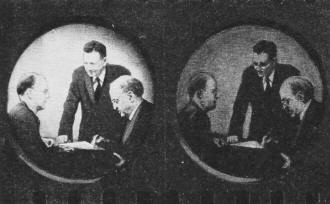|
What got my attention in this
1955 Radio & Television News magazine article was the
"picture-on-the-wall" concept being predicted by General Electric (G-E)
engineers, based on its light-amplifying phosphor invention. Determining exactly
how the device works is difficult based on the information given, but it appears
that the ultraviolet light source which is being amplified is projected onto the
surface of the amplifying substrate, and then an exact duplicate of the image is
reemitted toward the viewer. The conceptual drawing of a large screen hanging on
the wall is most likely driven by a UV projector located near the ceiling, akin
to how the large screen home theaters popular in the early 2000s worked (though
with no amplification by the screen). Obviously the scheme never came to
commercial fruition since such systems were never widely used. Other anticipated
applications included x-ray fluoroscopy, photography, "seeing-in-the-dark"
(aka infrared night vision) devices. Reading these vintage magazines reveals a
host of great science discoveries whose benefits never made it past the
laboratory experimentation phase.
Light Amplifier - A Long-Sought Scientific Goal

Dr. F. E. Williams (right) and D. A. Cusano demonstrate the amplification
of light.
"Picture-on-the-wall" television, improved x-ray techniques, etc. are much closer
to reality - thanks to G - E scientists.
Many exciting possibilities are envisioned as the result of a recent demonstration
of General Electric's new "light amplifier," a unit which amplifies light without
the use of electronic tubes.
Although this discovery may be the clue to achieving "picture-on-the-wall" television
screens, and to advancing the art of x-ray fluoroscopy, photography, "seeing-in-the-dark"
devices, and other developments involving reproduction of picture images, the company
is cautious about predicting any immediate application of this technique.
Interest in this phenomenon lay not so much in its immediate use but in the fact
that scientists are now able to increase the brightness of a projected photograph
by passing an electric current through a special phosphor cell which is used as
the viewing screen.

Elements of the special phosphor cell developed by scientists
at G-E to achieve direct amplification of light, without tubes.

Two photographs printed simultaneously from negatives made consecutively
on a roll of 35 mm film. The increase in brightness visible in the photograph at
the left is due entirely to the light amplification technique which involves a combination
of ultraviolet light, a special phosphor, and the application of a voltage to the
phosphor to give a light increase of ten times.
In the demonstration an ordinary lantern slide projector was employed and the
picture was a regular photoslide. The small screen produced a yellowish image when
an ultraviolet light source was used in the projector. As the voltage on the specially
prepared screen was increased, the picture became bright in the manner usually achieved
either by increasing the intensity of the projector light or by opening the lens
aperture. Neither the light nor the lens was altered, however, and the picture -
which was first barely visible - became many times brighter and clearer.
The demonstration further revealed that applying an electric voltage does not
of itself cause the special phosphor screen to give off light. Ultraviolet energy
falling on the screen causes a faint glow, but there is no amplification. Amplification
occurs only with voltage and the ultraviolet.
Proof of true amplification is obtained by measuring the number of photons of
light striking the screen and comparing this with the number given off. Increases
of at least ten times have been measured and the company believes much higher ratios
are possible. Because the amount of light produced is proportional to that striking
the surface, it is possible to brighten intermediate shades of the picture being
projected, making a brighter picture without "washing out" contrast.
The new light-amplifying phosphor, the basis of the light amplifier, was a development
of D. A. Cusano, a young General Electric scientist who conducted the demonstration.

Not much has been published to date on the idea of using a wall
screen for direct viewing in place of our conventional picture tubes. Many major
electronic companies are at the present time working on the idea which will, no
doubt. become a reality in the future. This new light amplifier may be a clue to
"picture-on-the-wall" developments, according to G-E.
Posted March 10, 2020
|













